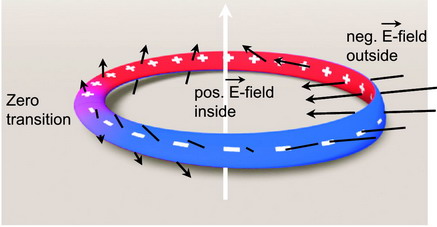Sub-Structure of the Electron
Updated April. 1st, 2023
To date, no detailed accepted theory
or model of the electron itself is established. What is
known is a variety of properties, each standing alone in
a table of elementary constants, an abstract entity like
the "brick" concept by R.
P. Feynman on something which cannot be devided in smaller
parts without leaving the "brick" identity.
There are several theoretical publications
which propose a rotating ring, a shell or mass-less particles
circulating with the speed of light, or in- and outcoming
standing waves, which explain many relevant aspects of the
electron like the spin and a diameter to be the Compton
wavelength. Several papers since Parson (1) describe models
of the ring electron (2) - the "spinning ring".
No one of these models, however gives a physical origin
of the charge itself.
At very close distances, however, the electron exhibits
a much stronger electrical field than during normal observations
- seen by the variation of the coupling constant at very
high energies. This looks, as if there were a stronger electromagnetic
field present than represented by the charge e-. Can the
electron be described as circulating purely electromagnetic
wave like a "knot of light" similar to that described
by Ranada
or Irvine&
Bouwmeester?
The field of a sine wave has a positive and a negative
half wave:

If looked at in space (right side), the underside of the
positive field vector has the effect of a negative field
per definition (see attraction of the positive test charge).
If we let the above wave circulate with an internal twist
like a Moebius ribbon in one turn (half sine phase of the
field), then the wave turns upside down for the next half
phase.
In this Moebius ribbon, the negative half wave stays on
the inside during the first revolution. After the internal
torsion, the underside of the negative half wave - i.e.
the postitively acting part of the second half wave is
on the outside of the particle again to give the
positron in the above case. If we reverse the polarities,
we obtain the electron:

As the field arrives on the other side of the ring with
some delay due to the speed of light, the inside field partly
compensates itself during one revolution. The excess positive
or negative field on the outside then is the origin of the
electric charge of the positron or electron, respectively.
The ratio of the field energy responsible
for the charge to the total particle rest energy is the
dimensionless figure 1/137, which is identical in value
and formula to the fine
structure or coupling constant. From the spin the
electric charge and the electron radius can be
calculated.
1) A. L. Parson, A Magneton Theory of the Structure of
the Atom, Smithsonian Miscellaneous Collection, vol. 65,
no. 11, Publication No. 2371, pp. 1-80 (Nov. 29, 1915).
(2) H. S. Allen, The Case for a Ring Electron, Proc.
Phys. Soc. London, vol. 31, pp. 49-68 (1919)
Mass Relation of Leptons and Nucleons
- Structure of the Quark (updated 10.01.2016)
One of the other key questions of
elementary particles physics is the mass relation between
leptons and nucleons, hadrons or quarks, or, more specifically,
the relation between the mass of the electron and the proton.
Every physicist since decades has wondered about the mass
relation between the electron and the proton of 1/1836.
However, leptons in many hadron decays
and interactions show a typical energy of 53 MeV. This energy
is found for electrons, positrons and even neutrinos which
are emitted from decay processes of mesons and from other
particle reactions.
The energy of 53 MeV is observed
so often that it cannot be a coincidence.
A simple spherical quantum wave is assumed for the quark.
Only six individual orbits of these high
energy electrons/positrons can be placed in this
spherical quark without violating the Pauli Principle.
Three quarks consisting of six of
these 53 MeV leptons per quark fit the observed mass and
charges of the proton minus a typical binding energy.
3 * 6 * 53 MeV - 2*8 MeV = 938 MeV - qed.
A factor of 53 times the rest energy
of the electron also has been calculated
1962 by P. Dirac to be the first excited state with
spherical symmetry according to the Bohr-Sommerfeld method
of quantization in a classical charged conducting surface.
The total energy then should be the sum of electrical and
magnetic energy to give a nucleon constituent with 53 MeV.
This spherical quantum wave can have eight quadrants in
a simple agitated version. The quark is shown to have exactly
and only three different variations of this eight quadrant
quantum wave, the colours.
Feedback or contact is appreciated
at physics@ccaesar.com